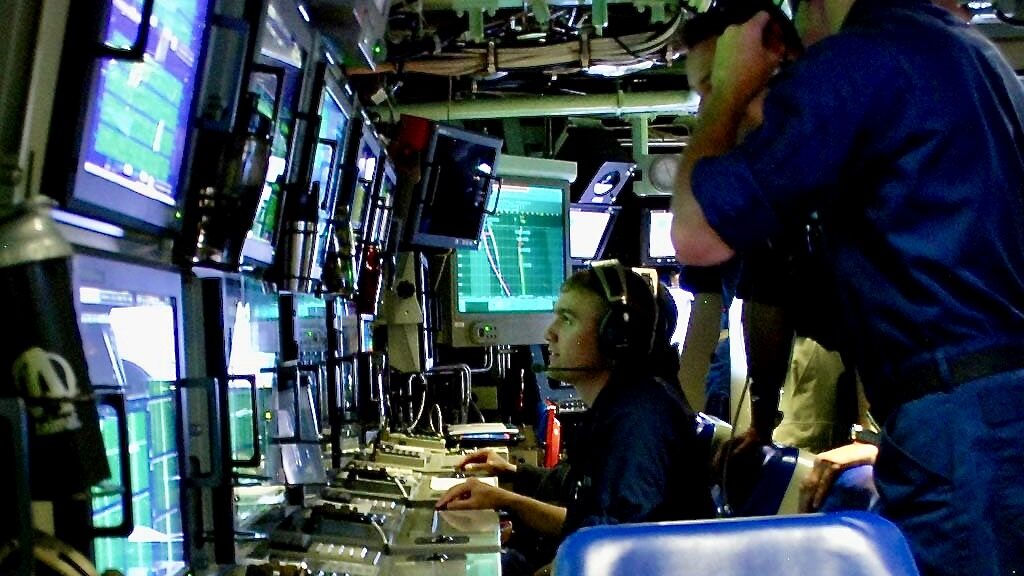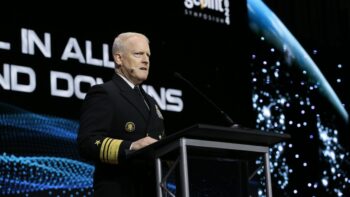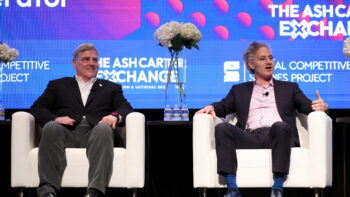
Control room of USS Minnesota, Virginia class submarine. Lockheed Martin builds the combat system for Virginia class subs of the US Navy and Collins class subs in Australia. Credit: Lt. Timothy A. Hawkins, US Navy
CANBERRA — News that the US Navy plans to build only one Virginia-class nuclear-powered attack sub next year sparked AUKUS critics here to decry the trilateral agreement as a bust, with former Australian Prime Minister Malcolm Turnbull claiming his country had been “mugged by reality” when the news broke.
The US needs to build 2.33 Virginia-class boats each year to meet both the requirements of the US Navy for 66 boats and to provide three to five boats to Australia. Despite a stated goal by the Navy to grow to two subs per year, production rates have been stuck at just over one each year. While advocates of AUKUS — and the US Navy in general — had hoped to see that number rise, the latest budget documents show the service plans to stay the course.
“This is really a case of us being mugged by reality. I mean, there’s a lot of AUKUS cheerleaders, and anyone that has any criticism of AUKUS is almost described as being unpatriotic. We’ve got to be realistic here,” Turnbull, a longstanding critic of the trilateral agreement, said March 12 to the Australian broadcasting Corporation. “The reality is the Americans are not going to make their submarine deficit worse than it is already by giving or selling submarines to Australia and the AUKUS legislation actually sets that out quite specifically.”
But Prime Minister Anthony Albanese and Defense Minister Richard Marles are standing staunchly by the plan to buy the Virginia-class boats and then for Australia to build a small fleet of its own. Asked March 13 at a press availability in Darwin if the proposed cut would affect Australia’s purchase of Virginia class submarines, Albanese replied: “No. Our plans are very clear going forward. We have an agreement that was reached with the United States and the UK. That legislation went through the US Congress last year. That was a product of a lot of hard work. It is in Australia’s interest to have a defense of our nation that is appropriate.”
The crux of the deal debate here is about whether the US plan to invest $11 billion over the next five years in the sub industrial base — new workers, new equipment and designs and other facilities — will be enough to help the two companies that build the subs, General Dynamics Electric Boat and HII’s Newport News Shipbuilding, get to the 2.33 rate.
“The fact that the American industrial base is stretched in 2024, as it was in 2023 when we made this announcement, is not news. It formed part of the landscape against which this arrangement was agreed a year ago. I think what’s important to see in the Budget that’s been put forward by the Biden administration is an $11 billion commitment over the next five years to grow the industrial capacity within the United States to produce Virginia-class submarines, which will see an increase over that time in the tempo of Virginia-class submarines produced,” Marles said in a March 13 interview on the Australian Broadcasting Corporation (ABC).
During the rollout of the Pentagon’s fiscal 2025 request senior DoD officials pointed to $3.9 billion set for submarine industrial base investment in the next fiscal year, some of which is long lead procurement so parts are ready and waiting. (While DoD can request funds, the Congress appropriates them, and has yet to actually pass appropriations for FY24.)
“We see [advanced procurement funding] as incredibly important in terms of supporting the supplier base to set ourselves up for the needed production rate both for Virginia-class… [and] we include support for Columbia-class,” Navy Undersecretary Erik Raven said. Raven elsewhere said the service anticipates the Virginia-class program will hit the two-sub-per-year delivery cadence by 2028.
Pentagon comptroller Mike McCord said the Pentagon cut to one submarine buy so it would not keeping doing the same thing over and over, which had not resulted in an appreciable production increase.
“The boats that are delivering … this year are averaging over 30 months late, and we have more than a dozen on order that are still in production already. So the question was really: ‘What can we do to get a better result [rather] than keep doing the same thing and hoping for a different result?’”
Marles noted that nuclear boat patrols and visits to Australia have already begun to increase, which was a less-noted, but still important, part of the AUKUS agreement.
“And we should just remember that, of course, the first of the submarines is not a new submarine. That’s part of the announcement that we made last year. I think if we take a step back, when we made this announcement last year in the last twelve months we’ve seen a power of work be undertaken by us here in Australia, but in the UK and very much in the US as well, the very first step was to see an increase in the number of nuclear powered submarine visits to Australia. There’s an LA class submarine at HMAS Sterling right now, the USS Annapolis, and we have seen that increased tempo of submarines come to Australia,” Marles said.
Turnbull, however, pointed to legislation that could let the US stop the transfer of any boats “if doing so would ‘degrade the US undersea capabilities’. Budgeting for one submarine all but guarantees this.” he claimed.
In the end, Marles said “the US government has been meeting its commitments and continues to do so.”
And the Navy has a long tradition of identifying programs to cut that it knows Congress will restore.
Rep. Joe Courtney, D-Conn. and co-chair of the so-called AUKUS Caucus and one of the most senior defense lawmakers, castigated the Navy plan when it was announced. And the top leadership of the House Armed Services Committee, Chairman Mike Rogers, R-Ala. and Ranking Member Adam Smith, D-Wash., in January joined with Courtney and Rep. Trent Kelly, R-Miss., the head of the HASC’s Seapower and Projection Forces subcommittee, to send a letter in mid-January to President Joe Biden urging his administration to maintain a two-per-year sub buy rate.
UPDATED 3/14/2024 at 2:30pm ET to correct a reference to Los Angeles-class submarines.






















